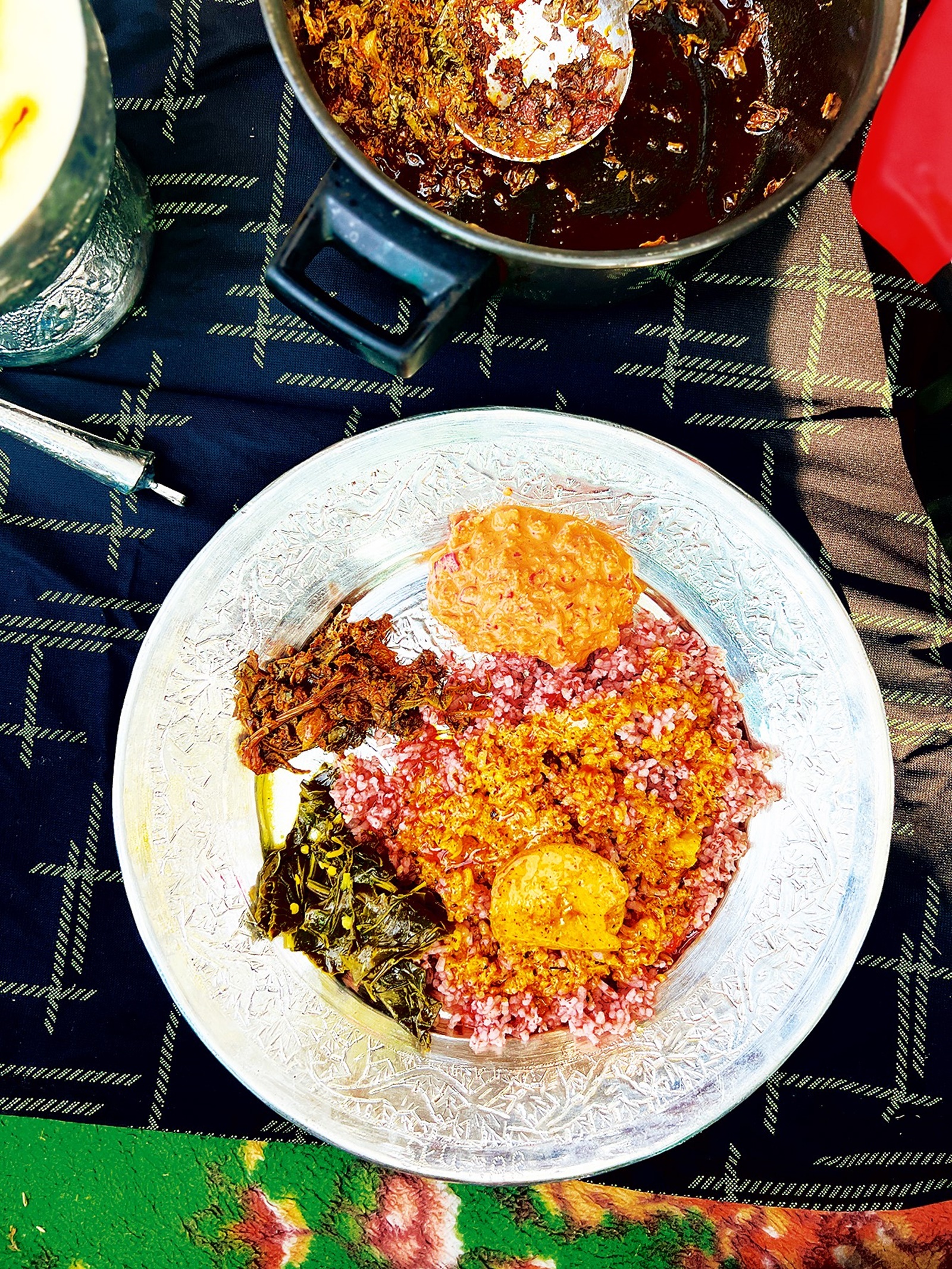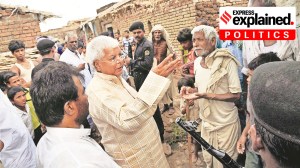Can the world of food expand beyond chef whites and restaurants
A trip through Kashmir to forage for indigenous ingredients led us to the women who are keeping its culinary heritage and produce alive
 Chef Vanshika Bhatia (centre) with fellow travellers and Afshan Rashid (in red) in Kashmir (Credit: Vernika Awal)
Chef Vanshika Bhatia (centre) with fellow travellers and Afshan Rashid (in red) in Kashmir (Credit: Vernika Awal)I want my daughter, Jannat, to learn essential skills, of knowing how her food grows, how to process it and to live and thrive in nature,” says Afshan Rashid, a Kashmir-based journalist-turned-farmer. Rashid has a gentle but firm gait as she walks us through her passion project – her farm in Pulwama, an hour’s drive away from Srinagar.
Called Baag Manzuk in Kashmiri, meaning ‘from the garden’, and spread across eight acres Rashid took over from her father, after the land lay barren for many years. With her husband Mumin, the 32-year-old began growing vegetables and fruits for the family, which soon expanded to the community, as well.
But the primary motive was to give three-year-old Jannat a shot at a raw, earthy, unfiltered future. As we soaked it all in, it struck me that Rashid’s daughter’s name was befitting of where we stood.
We were at Baag Manzuk through an invitation by Chef Vanshika Bhatia and her team from OMO Cafe in Gurugram on a foraging expedition through Kashmir. The goal was simple — find quaint stories that narrated forgotten tales of what we eat, and why we eat them. Food, as great minds over time have said, is often more socio-politically relevant than what we give it credit for. Here, standing on a patch of land where the rest of our everyday worlds lay forgotten, one truly felt it.
 Apples at Anjum Yousuf’s farm near Manasbal Lake in Kashmir (Credit: Vernika Awal)
Apples at Anjum Yousuf’s farm near Manasbal Lake in Kashmir (Credit: Vernika Awal)
We were welcomed by a vine of kiwis forming a gateway to the patch where myriad other vegetables grew. The farm produced aubergine, red okra, radish, rhubarb leaves, Kashmiri red chillies, fresh walnuts and collard greens, most of which were ready to be harvested. The apples had just been plucked to ensure that they reached the markets in crisp condition.
Tying this part together was Rashid’s aunt, the matriarch of the family. A woman of few words, she exuded a warmth that one could bask in forever. Soon, we were all put to work — foraging for dandelion greens or haandh as they are called in Kashmiri. Foraging for them appeared to be a regular activity in the community.
Quixotically, there we stood — an army of urban cocooned aliens who had not a clue what haandh looked like. It was our first lesson of day one — learn to recognise the greens, to be able to find something to feed ourselves for dinner. Jannat, though, knew exactly what haandh looked like.
Soon enough, we had gathered around the table for a home-cooked Kashmiri feast. Rashid and her family ensured that we not only got to savour the flavours, but they also appreciated our hard work that went into growing, foraging and harvesting the produce. We were suddenly thankful for the food on our plates — something that we often take for granted.
The food in Kashmir uses minimal spices and ingredients, but is bold in flavours. Fennel, dried ginger powder, Kashmiri red chilli powder and dried mint are used generously in the making of almost any dish, and the preferred souring agent is yoghurt—as tomatoes are hard to come by at this altitude. The usage of dried vegetables like aubergines, gourds and beans is high, as during the harsh winters, fresh vegetables are rare. Even meat dishes use a lot of these dried vegetables in them during the off-seasons, and fresh ones when in bloom.
One of the dishes that Rashid’s aunt made, which was loved by all, was bumtchoonth te maaz (lamb gravy with quince apples). The dandelion leaves we so skilfully foraged were added to a second dish — haandh saag. That, in all the glory of simplicity, was lunch for the day.
*******
Modern-day chefs go on foraging expeditions as qualitative exercises — not quantitative ones. In the process, they come across farms, such as Rashid’s, where they learn about the significance of an ingredient and its versatility. This knowledge, carried back to urban hubs through postcards, diary notes and Instagram filters, translates to exotic dishes on a restaurant’s menu.
The purpose they serve are manifold. On one hand, they differentiate what a restaurant offers. This is even more important if the venture serves vegetarian fare as their core offering, Chef Bhatia’s OMO Cafe is a case in point. It also adds to a restaurant’s sustainability quotient.
For more such discoveries, we reached a second farm owned by Anjum Yousuf, near Manasbal Lake. Here, juicy apples welcome us, on luxuriant trees as far as the eyes could see. Yousuf insisted that we pluck and eat from her ‘Red Delicious’ variety. It’s these simple joys of biting into the purest apples that made us ponder upon the produce that we eat in cities.
 A home-cooked Kashmiri meal (Credit: Vernika Awal)
A home-cooked Kashmiri meal (Credit: Vernika Awal)
Yousuf’s farm, a self-sustaining ecosystem, also offers locals some of the best nadru (lotus roots) and gaadh (freshwater fish). Being close to the lake, the land was more fertile than Rashid’s, though both were incomparable in their hospitality. Yousuf spoiled us with kahwa, hot cakes and bread from her local kandur (baker).
Initially, Yousuf only kept cattle, and her ghee, mozzarella cheese and Kashmir’s famous kaladi cheese were most popular among the community. Over time, Yousuf and her husband began growing vegetables, using the produce to make murabbas and jams. Soon, they found a market for their organic produce. Called The Farmhouse Kashmir, their label has been on the shelves for over five years, without any urban startup hullabaloo.
In one glass bottle was a fiery red paste, which Yousuf called “special waer masala”. “We make it using pran (shallots), Kashmiri garlic and red chillies,” she said.
As we strolled around Srinagar, we found women selling ‘waer tikki’. This sharp, pungent spice mix is sold in the solid form to keep in the harsh winter months. Made on a mortar and pestle, it is judiciously stored to ensure that there’s always enough waer masala at home to add zing to traditional dishes.
In a world of pre-made spice mixes, the waer masala continues to thrive untouched by corporate commercialism to an extent. It also empowers communities; every trader and seller we met who ferried the masala was a woman.
At the heart of this tradition-driven trip was not just Yousuf, Rashid and Jannat or the chefs of OMO — Bhatia, Muivah Grace and partner Deepika Sethi, it was also the numerous women we met along the way, as we foraged, cooked, wandered, who play key roles in the economy and society of Kashmir. It was a testimony to what Bhatia said: The world of food expands well beyond chef whites and restaurants.
Photos



- 01
- 02
- 03
- 04
- 05




























